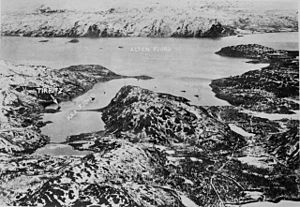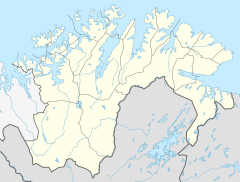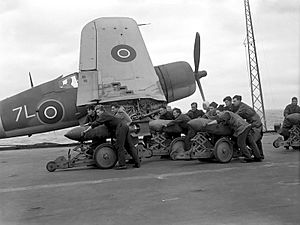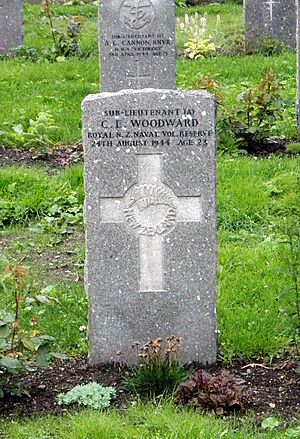Operation Goodwood (naval) facts for kids
Quick facts for kids Operation Goodwood |
|||||||
|---|---|---|---|---|---|---|---|
| Part of World War II | |||||||
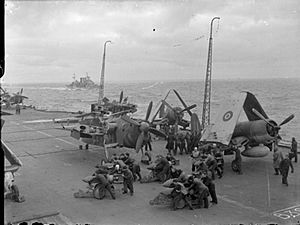 Barracuda bombers and Corsair fighters being armed on the flight deck of HMS Formidable during Operation Goodwood |
|||||||
|
|||||||
| Belligerents | |||||||
| Commanders and leaders | |||||||
| Casualties and losses | |||||||
| 17 aircraft 1 frigate sunk 1 escort carrier damaged beyond repair |
12 aircraft 1 battleship lightly damaged 7 other ships damaged |
||||||
Operation Goodwood was a series of air attacks by British aircraft carriers in August 1944. Their target was the huge German battleship Tirpitz. This ship was hiding in a place called Kaafjord in Norway, which was controlled by Germany at the time. This operation was the last of many attempts by the British Home Fleet to sink Tirpitz. The goal was to remove the threat it posed to Allied ships during World War II. Unlike earlier attacks, Operation Goodwood involved several air raids over one week. The Royal Navy hoped these repeated attacks would wear down the strong German defenses.
The British fleet left its base on August 18. The first attack on Kaafjord happened on the morning of August 22. This attack, and a smaller one that evening, did not cause much damage. More attacks took place on August 24 and 29, but they also failed. Tirpitz was hit by two bombs on August 24, but neither caused serious harm. During Operation Goodwood, the British lost 17 aircraft. They also lost one frigate (a type of warship) which was sunk by a German submarine. An escort carrier (a smaller aircraft carrier) was also badly damaged. German forces lost 12 aircraft and had 7 other ships damaged.
After Operation Goodwood, the job of attacking Tirpitz was given to the Royal Air Force. In September and October 1944, the RAF used heavy bombers to attack the battleship three times. These attacks first crippled Tirpitz and then finally sank it. Many historians believe Operation Goodwood was a big failure for the British Fleet Air Arm (the Royal Navy's air force). They often blame the aircraft and weapons used for the poor results.
Contents
Why Attack Tirpitz?
From early 1942, the German battleship Tirpitz was a big danger to Allied convoys. These convoys were groups of ships carrying important supplies to the Soviet Union through the cold Norwegian Sea. Tirpitz was stationed in fjords (narrow sea inlets) along the Norwegian coast. It was powerful enough to destroy the smaller warships protecting the convoys. It could also break out into the North Atlantic Ocean. To stop this threat, the Allies had to keep many powerful warships with the British Home Fleet. Large warships often sailed with the convoys for part of their journey.
Many air and sea attacks were launched against Tirpitz in 1942 and 1943. On March 6, 1942, torpedo bombers from the aircraft carrier HMS Victorious attacked the battleship. Tirpitz was trying to stop Convoy PQ 12, but the bombers missed. The Royal Air Force and Soviet Air Forces also tried to bomb Tirpitz several times in 1942 and 1943. However, they failed to cause any damage. On September 23, 1943, two British midget submarines managed to get past the defenses around Kaafjord. They placed explosive charges under Tirpitz. This attack, called Operation Source, caused a lot of damage. It put the battleship out of action for six months.
After Operation Source, the Home Fleet's aircraft carriers were given the job of attacking Tirpitz. After months of planning, a successful attack called Operation Tungsten happened on April 3, 1944. This operation involved two groups of 20 Fairey Barracuda dive bombers. They were protected by 40 fighter planes. Tirpitz's crew suffered many casualties, but the battleship itself was not badly damaged. Still, it was out of action for several more months while repairs were finished.
The Home Fleet launched four more raids against Tirpitz between April and July 1944. However, the battleship was only attacked during the last one. These attacks faced problems because many experienced British airmen were moved to other units. The new aircrew were not as skilled. The first raid, Operation Planet, started on April 21 but was called off due to bad weather. The next raid, Operation Brawn, also faced heavy clouds over Kaafjord on May 15. The planes had to return without attacking. Operation Tiger Claw in late May was also cancelled because of bad weather. The next attack, Operation Mascot, was planned for mid-July. This was before the Arctic convoys started again. Forty-four Barracudas and 40 fighters were sent on July 17. They reached the target area, but Tirpitz was hidden by a protective smokescreen. The attack failed to damage the battleship.
Planning the Attack
In the weeks after Operation Mascot, Tirpitz kept getting ready for possible battles. German spies reported that the battleship was training and getting more smoke generators. The British thought this meant Tirpitz was preparing to attack Allied shipping. To stop this, the British decided to attack the battleship again in Kaafjord. This would happen when the next group of Arctic convoys sailed. In truth, the German Navy did not plan to use Tirpitz to attack. It would be too easy for the stronger Allied ships and planes to find it. Instead, Tirpitz was kept active to force the Allies to keep many warships and aircraft tied up in Norway.
The failure of Operation Mascot made Admiral Sir Henry Moore, the commander of the Home Fleet, think that the Fleet Air Arm's main attack plane, the Fairey Barracuda dive bomber, was not good enough for Kaafjord. The Barracudas were slow. This gave the German defenders enough time to cover Tirpitz in a smokescreen before the planes arrived. Moore thought more attacks with these planes would be useless. However, the British Admiralty (the Navy's headquarters) believed that hitting Kaafjord repeatedly with Barracudas over 48 hours might weaken the German defenses. It might also use up all the fuel for Tirpitz's smoke generators. Moore agreed to try attacking Tirpitz again, even though he had doubts.
Admiral Moore's plan for the new attack, called Operation Goodwood, involved British aircraft attacking the Kaafjord area over several days. In earlier raids, fighter planes only used their machine guns to shoot at German defenses. This was to make it safer for the Barracudas. But for Operation Goodwood, some fighters would also drop bombs. Two squadrons of Corsairs and one squadron of Hellcats were chosen for this. They practiced dive-bombing before the operation. Another new idea was to use Fleet Air Arm planes to drop mines near Tirpitz and the entrance to Kaafjord. The mines near the battleship would have time-delay fuses. The British hoped the explosions would make Tirpitz move into safer waters, forcing it through the minefield at the fjord's entrance. Before Operation Goodwood, the Home Fleet's flying squadrons practiced at a target range in Loch Eriboll in northern Scotland. This area was similar to Kaafjord.
Forces Involved
The British attack fleet for Operation Goodwood was split into three groups. Admiral Moore was on board the battleship HMS Duke of York. This ship sailed with the aircraft carriers HMS Indefatigable, Formidable, and Furious. Two cruisers and fourteen destroyers also joined them. The second group had the escort carriers HMS Nabob and Trumpeter, the cruiser HMS Kent, and several frigates. Two fleet oilers (ships that carry fuel) sailed separately. They were protected by four corvettes (small warships) and supported the two attack groups.
The aircraft carriers carried the largest group of Fleet Air Arm planes ever put together during the war. The main attack planes were 35 Barracudas. These were spread across four squadrons (820, 826, 827, and 828 Naval Air Squadrons) and flew from the three large carriers. Two units of 6 Naval Fighter Wing, 1841 and 1842 Squadrons, flew 30 Corsairs from Formidable. A total of 48 Seafires were on board Indefatigable and Furious. In addition, 1770 and 1840 Squadrons operated 12 Fairey Firefly and 12 Hellcat fighters respectively from Indefatigable. The two escort carriers had 20 Avengers (which were supposed to drop mines) and 8 Wildcat fighters. These planes were from 846 Squadron on Trumpeter and 852 Squadron on Nabob.
Tirpitz's anchorage at Kaafjord was very well defended. Before Operation Tungsten, there were eleven anti-aircraft gun batteries, several anti-aircraft warships, and a system of smoke generators. These could hide Tirpitz from planes. After that attack, more radar stations and observation posts were set up. The number of smoke generators was also increased. Tirpitz's own air defenses were made stronger. It got more 20 mm cannons. Its 150 mm guns were changed so they could shoot at planes. Even its huge 380 mm main guns were given anti-aircraft shells. The German Air Force (Luftwaffe) had few fighter planes near Kaafjord. Their operations were also limited because they didn't have much fuel.
The Attacks
August 22 Raids
The Operation Goodwood attack fleet set sail on August 18. The timing was chosen so the Home Fleet could also protect Convoy JW 59. This convoy had left Scotland on August 15, heading for the Soviet Union. The journey north was quiet. The attack forces arrived off Norway on August 20. The first attack on Kaafjord was planned for August 21. However, the weather was too bad for flying, so Admiral Moore delayed it by 24 hours. The Germans first knew the British fleet was there on August 21. They detected radio messages from the carriers.
The first attack on Kaafjord was launched on August 22. The flying conditions were poor due to low clouds. But Moore decided to attack anyway because some of his ships were running low on fuel. They would soon need to leave Norway to refuel. At 11:00 am, a force of 32 Barracudas, 24 Corsairs, 11 Fireflies, 9 Hellcats, and 8 Seafires took off from the three large carriers. No Avengers were sent because the cloudy weather was not good for their mission. Few mines were available, and the Avengers could not land safely with them. So, if the planes couldn't find Tirpitz, they would have to dump their mines into the sea, wasting them.
As the planes got closer to the coast, they saw heavy clouds over the hills near Kaafjord. The clouds made accurate bombing impossible. So, the Barracudas and Corsairs went back to the carriers without attacking. The Hellcat and Firefly fighters kept going. They approached the fjord flying below the clouds. These planes surprised the Germans. Tirpitz was not hidden by smoke when they arrived over Kaafjord. The Fireflies started the attack at 12:49 pm. They shot at German anti-aircraft guns on and around Tirpitz. Two minutes later, nine Hellcats attacked the battleship with 500-pound bombs. But they did not hit it. As the planes returned to the carriers, they destroyed two of Tirpitz's seaplanes in Bukta harbor. They also badly damaged the submarine U-965 at Hammerfest. At Ingøy, north of Hammerfest, three Hellcats shot at a German radio station. The attack set the station's buildings on fire and damaged its antennas. The eight Seafires made distraction attacks on the Banak area and a nearby seaplane base. They destroyed five German seaplanes. The British lost three aircraft during this morning attack. One Hellcat and one Seafire were shot down. One Barracuda had to ditch into the sea on its way back.
After the planes returned, much of the Home Fleet sailed away from the Norwegian coast to refuel. A group including Formidable, Furious, two cruisers, and several destroyers headed for the two fleet oilers. The escort carrier group also left so the carriers could refuel their escort ships. At 5:25 pm, Nabob was hit by a torpedo from U-354. The carrier was seriously damaged, and 21 sailors died. But it could still do some flight operations. Soon after, U-354 torpedoed the frigate HMS Bickerton. Bickerton was searching for Nabob's attacker. Nabob had to return to the Home Fleet's base at Scapa Flow that evening. Trumpeter, a cruiser, and several destroyers escorted it. Formidable and Furious covered their withdrawal. During this time, Furious also refueled from the Home Fleet's tankers. With both escort carriers gone, the mine-dropping part of Operation Goodwood had to be cancelled. Bickerton's back end was destroyed by the torpedo. It could have been saved. However, the commander did not want to protect two damaged ships. So, the frigate was sunk on purpose around 8:30 pm on August 22. Soon after the attacks on Nabob and Bickerton, Seafires from 894 Naval Air Squadron shot down two German Blohm & Voss BV 138 reconnaissance planes.
On the evening of August 22, eight Fireflies and six bomb-armed Hellcats from Indefatigable attacked Kaafjord again. This was the first of several small attacks meant to wear down the German defenses. German forces did not detect the planes before they arrived over Kaafjord at 7:10 pm. The Fireflies shot at German gun positions, killing one of Tirpitz's crew and wounding ten. However, the Hellcats' bombs did not damage the battleship. The British fighters also attacked other German ships and radar stations on their way back. They damaged two tankers, a supply ship, and a patrol boat. No British planes were lost in this raid.
August 24 Attack
Fog caused the cancellation of Indefatigable's flying operations on August 23. This included a planned distraction attack against German ships in Langfjord. The other two carriers and their escort ships rejoined Moore and Indefatigable off Norway on the morning of August 24. The weather was foggy at first, but it cleared enough in the afternoon for an attack on Kaafjord. The attacking force had 33 Barracudas carrying 1600-pound armor-piercing bombs. It also included 24 Corsairs (5 of which carried a 1,000-pound bomb), 10 Hellcats, 10 Fireflies, and 8 Seafires. To try and surprise the Germans, the planes took off from the carriers further south than in earlier raids. The planes then flew parallel to the coast. They then turned inland and approached Kaafjord from the south. A German radar station detected the force at 3:41 pm. It immediately warned Tirpitz.
The British attack began at 4:00 pm. It started with Hellcats and Fireflies attacking German gun positions. These planes were five minutes ahead of the Barracudas and Corsairs. Tirpitz's protective smokescreen was not fully in place at the start of the raid. But by the time the Barracudas and Corsairs arrived, the battleship was completely covered in smoke. Because of this, these planes had to drop their bombs without seeing the ship. They released their weapons from heights between 5,000 and 4,000 feet. Only two bombs hit Tirpitz. The first was a 500-pound bomb dropped by a Hellcat. It exploded on the roof of her "Bruno" main gun turret. The explosion destroyed the four 20 mm anti-aircraft guns on top of the turret. But it did not cause any major damage to the turret itself. The second bomb to hit the ship was a 1600-pound armor-piercing bomb. It went through five decks, killed a sailor in a radio room, and stopped near an electrical switch room. This bomb did not explode. German bomb experts later found that it was only partly filled with explosives. The German report on the attack said that if the bomb had exploded, it would have caused "immeasurable" damage. British fighters also attacked other German ships and buildings in the Kaafjord area. They damaged two patrol boats, a minesweeper, and a radar station. They also destroyed an ammunition dump and three guns of an anti-aircraft battery. Tirpitz's last remaining Arado Ar 196 seaplane was attacked in Bukta harbor and damaged beyond repair. Four Corsairs and two Hellcats were shot down during the raid. The battleship's crew had 8 deaths and 18 wounded. Many anti-aircraft units around Kaafjord suffered heavy losses.
At 7:30 pm on August 24, two Fireflies flew over Kaafjord to take photos and gather information on the attack's results. Their presence caused the Germans to create a smokescreen over the fjord and fire many anti-aircraft guns. In a separate event that day, U-354 was sunk off Bear Island. This was done by Fairey Swordfish planes from the escort carrier HMS Vindex, which was protecting Convoy JW 59.
The German command at Kaafjord thought the attacks on August 24 were "undoubtedly the heaviest and most determined so far." They asked for fighter planes to be moved from northern Finland to strengthen the area's defenses. But because Germany's fighter force was needed elsewhere, this request was turned down on August 26 by the Luftwaffe headquarters.
Strong winds and fog stopped the British from making more attacks between August 25 and 28. On August 25, Indefatigable, Formidable, two cruisers, and seven destroyers refueled from the oilers. Both cruisers later left the force and went back to Scapa Flow. Duke of York, Furious, a cruiser, and five destroyers also sailed to the Faroe Islands to get supplies. Before leaving the fleet, Furious transferred two Barracudas and two Hellcats to Indefatigable. Since the old Furious was no longer fit for battle, it went from the Faroe Islands to Scapa Flow with the cruiser and several destroyers. On August 29, Duke of York and the remaining destroyers rejoined the main Home Fleet off northern Norway. During this time, the flying squadrons' maintenance crews worked to repair planes damaged during the August 24 attacks.
Convoy JW 59 finished its journey on August 25. Most of its ships docked at Kola in northern Russia. The convoy had been attacked many times by U-boats from August 20 to 24. Its escorting warships and aircraft sank two submarines. All the merchant ships arrived safely. The only Allied loss was the sloop HMS Kite, which was torpedoed and sunk by U-344 on August 21.
August 29 Final Attack
The last attack of Operation Goodwood happened on August 29. The attack force included 26 Barracudas, 17 Corsairs (two of which carried 1,000-pound bombs), 10 Fireflies, and seven Hellcats. Seven Seafires also made a distraction raid on Hammerfest. To help the bombers aim accurately once the smokescreen was created around Tirpitz, four of the Hellcats carried target indicator bombs. The planes started launching at 3:30 pm.
The British planes failed to surprise the Germans. German radar stations had been tracking the Home Fleet's regular anti-submarine and fighter patrols. The Seafires were detected at 4:40 pm when they were 54 miles from Kaafjord. Because of this warning, the smoke generators around Kaafjord were turned on, and the fjord's defenders went to their battle stations. The main group of British planes arrived over Kaafjord later than expected. This was due to stronger than predicted winds and a navigation mistake. They did not reach the target area until 5:25 pm. By this time, Tirpitz was covered in a very thick smokescreen. None of the British airmen could see the ship. The Barracudas and Corsairs had to drop their bombs on Kaafjord without seeing the target. No direct hits were made on the battleship. However, six of her crew were wounded by bomb fragments from bombs that landed nearby. German ships and gun positions were again shot at by the fighters, but no major damage was done. Heavy anti-aircraft fire from Tirpitz, guided by observers on a nearby mountain, shot down one Corsair and one Firefly.
After the raid on August 29, the Home Fleet sailed west. They went to cover Convoy RA 59A, which had sailed from northern Russia on August 28, heading for the UK. Due to a lack of fuel, Indefatigable and three destroyers left the group later that day to return to Scapa Flow. Formidable with two destroyers followed 24 hours later. Duke of York and six destroyers stayed in the Arctic Sea until 11:00 am on September 1. By then, the convoy was considered safe from attack.
Overall, the Fleet Air Arm lost 40 airmen and 17 aircraft during Operation Goodwood. Nabob was also considered too damaged to repair economically, and it was taken out of service. On the German side, Tirpitz only suffered minor damage.
What Happened Next
After the August 29 raid, the British learned through secret Ultra intelligence that Tirpitz had not been seriously damaged during Operation Goodwood. In public statements, the Royal Navy claimed to have damaged or sunk 19 German warships during the attacks on Kaafjord. However, they did not report any damage to Tirpitz.
During the last days of Operation Goodwood, Royal Navy planners decided not to order any more Fleet Air Arm attacks on Kaafjord. The planners accepted that the Germans could now cover Tirpitz in smoke before the Barracudas could reach the battleship. Also, these aircraft could not carry bombs big enough to cause heavy damage. They thought about attacking Kaafjord using Mosquito bombers launched from aircraft carriers. But these light bombers were still in short supply. It was also decided that they were not well suited for the job. Plus, there was a growing need to send the carriers to the Pacific to help Britain's efforts in the war against Japan.
Tirpitz was still seen as a threat to shipping. So, the British Chiefs of Staff Committee and General Dwight D. Eisenhower, the Supreme Allied Commander, decided in late August to attack it again. This time, they would use Royal Air Force heavy bombers. On September 15, a group of Lancasters attacked Kaafjord. They refueled at bases in northern Russia first. This attack caused damage to the battleship that could not be repaired. After this raid, Tirpitz sailed to an anchorage near Tromsø. It was then used as a stationary coastal defense battery. Another heavy bomber attack on October 29 caused only minor damage. In a third raid on November 12, Tirpitz was hit by several Tallboy bombs. It then flipped over and sank, with many lives lost.
Historians generally agree that Operation Goodwood was a failure. In 1961, the British official historian Stephen Roskill said the attacks were the end of "a series of operations whose results can only be classed as intensely disappointing." He concluded that sinking Tirpitz was "remote" because of the Barracudas' weaknesses and their weapons. Similarly, Norman Polmar wrote in 1969 that Operation Goodwood was "perhaps the most striking failure of the F.A.A. (Fleet Air Arm) during World War II." He said it was directly due to the lack of effective aircraft. The Barracudas were too slow and could not carry bombs big enough for effective attacks. More recently, Mark Llewellyn Evans called the results of Operation Goodwood "pathetic." Mark Bishop concluded that "the Fleet Air Arm's greatest operation of the war ... ended in failure."


